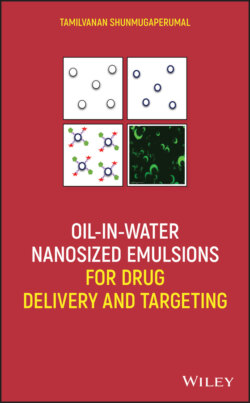Читать книгу Oil-in-Water Nanosized Emulsions for Drug Delivery and Targeting - Tamilvanan Shunmugaperumal - Страница 31
2.2.4. Importance of Neutral‐Charged (Sterically Stabilized) Nanosized Emulsions
ОглавлениеIn many cases, however, greater emulsion stability can be achieved without imparting a significant surface charge to the emulsion droplets, by means of steric stabilization (Capek 2004). Nonionic surfactants possessing bulky hydrophilic groups like PEO protruding into the dispersion media decrease coalescence arising from droplet collisions. Another contribution to the steric stabilization of emulsions by nonionic surfactants is provided by the close packing of PEO chains at the droplet surface. The compact packing of PEO chains at the droplet surface creates steric stabilization because little or no interpenetration of PEO chains on different droplet surfaces occurs due to entropic repulsion (Dale et al. 2006). Large head groups carrying simultaneously charges of opposite signs, such as in zwitterionic surfactants, can cause similar effects. In polar dispersion media of low‐to‐medium ionic strength, these groups are, as a rule, strongly solvated (hydrated in the most common case of H2O) (Yaseen et al. 2006). Voluminous and on an average almost non‐charged hydration shells, surrounding the emulsion droplet, possess a significant steric rigidity and can also effectively stabilize emulsions. There are, however, only a few examples in the literature that use zwitterionic surfactants as effective emulsion stabilizers. For example, lecithin was used for the stabilization of perfluorooctyl bromide (PFOB) in water emulsions, to be used as oxygen‐carrying system in a bio‐artificial liver device (Moolman et al. 2004). The Sauter mean diameter of 0.2 μm PFOB emulsion droplet in water was obtained by high‐pressure homogenization. The emulsion was stable for several months even at a volume fraction of 20%. Nonionic surfactants are more often used for emulsion stabilization than zwitterionic phospholipids because they are synthetically manufactured, can be well defined analytically, and have significantly less batch‐to‐batch variation than naturally occurring (egg yolk, soybean) lecithins.
The nonionic surfactant Span‐83 was used for stabilizing water droplets in oil to form a reactive storage carrier for the synthesis of calcium carbonate nanoparticles by means of a two membrane system (Hu et al. 2004). Firstly, an aqueous emulsion was prepared in kerosene stabilized by 0.02596 wt% Span and containing CO3−2 ions in the droplets of the dispersed phase. The oil phase contained also a 0.02792 M solution of bis(2‐ethylhexyl) hydrogen phosphate (2DEHPA), a well‐known molecular carrier for the transportation of metal ions across emulsion liquid membranes (ELM). In the second stage, a CaCl2 aqueous solution‐filled dialysis tube was placed into the o/w emulsion and due to the reaction between CO3−2 and Ca2+ ions in the aqueous droplets, CaCO3 nanoparticles were obtained. Similarly, ZnS nanoparticles were prepared in inverse water‐oil‐emulsion (Naskar et al. 2006). The stabilization of emulsions was provided by the addition of 5 wt% of Span 80 or Span 20, respectively, to the oil phase (cyclohexane). The dispersed phase contained a mixture of zinc acetate and thioacetamide, which react upon heating to form ZnS. The authors demonstrated that for the preparation of ZnS nanoparticles, the use of Span 20 was more favorable because of the smaller emulsion droplet size and therefore lower and more homogeneous size of the final particles. Another advantage was the higher stability of Span 20 against hydrolysis as compared to Span 80.
In general, fulfilling both stabilization mechanisms (smaller droplet size and lesser susceptibility of surfactant toward chemical degradation) simultaneously leads not only to the highest emulsion stability but also to lesser sensitivity to changes in the external conditions such as pH, ionic strength, and temperature. Therefore, the use of mixtures of different classes of surfactants for emulsion stabilization is frequently the most effective solution in many practical cases.
